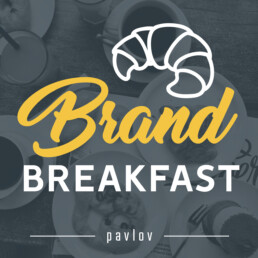Facing industry challenges using a strong logistics or maritime brand
The logistics and maritime market is in constant evolution. As a trusted brand advisor to some of the industry’s leading organisations, we are in the front row to observe how these evolutions present a series of complex challenges, which usually go beyond merely the operational aspects of doing business.
A growing demand for relevant services reveals a series of difficulties and uncertainties for the future, such as the arduous search for qualified employees, translating environmental goals into reality and a narrative that is picked up by the general public, the surge in potential competitors in your field, the rising expectations of your own clients and their customers, and dealing with the ongoing wave of consolidation in the industry.
Making the difference with a strong logistics brand
Fortunately, at Pavlov, we start from the philosophy that strong brands make things possible. Smart organisations with a clear strategy ensure their brand becomes their most valuable asset. And let just that be exactly what we excel at as an independent niche consultant in branding: the valuable positioning of brands in the market, making them not only resilient in volatile times, but also attractive to internal and external audiences.
Translating this brand strategy, crafted based on solid insights into your market and your target audience, into your brand story, customer experience, brand culture and brand identity ensures your organisation achieves a sustainable position that makes a real difference.
Download your free copy of this 16 page whitepaper and let our experts help you discover how precisely your brand makes this difference, based on current challenges specific to your industry and the solutions that a strong brand can provide.
Download your free copy

Episode 59: Jubileumaflevering met het beste uit 5 jaar Brand Breakfast

Episode 59: Jubileumaflevering met het beste uit 5 jaar Brand Breakfast
Bijna dag op dag 5 jaar geleden, op 28 juni 2018, ging de eerste aflevering van Brand Breakfast online. We misten bij Pavlov een degelijke, Nederlandstalige podcast over branding en marketing en besloten er immers zelf maar een te gaan maken. Met twee basismicrofoons en een USB-mengpaneeltje waagden Stef en Michaël zich aan het audio-avontuur.
Vijf jaar en net geen 60 afleveringen later mogen we terugkijken op een mooie catalogus aan episodes over de meest uiteenlopende branding topics, en meteen ook op een impressionante reeks gasten die plaats namen voor onze – intussen professionele – microfoon.
Om deze verjaardag de nodige luister bij te zetten, doken Michaël en Stef in al die uren aan opnames om er hun favoriete, meest inspirerende en opvallendste fragmenten uit te selecteren. De uiteindelijke selectie van 8 fragmenten beluisteren we graag nog eens samen met jullie, en voorzien we meteen van een bijkomend woordje commentaar.
In deze jubileumaflevering komen verschillende inzichten aan bod. Zo herinneren we ons hoe Taha Riani (episode 28) erin slaagde onze blik op diversiteit grondig te veranderen, bespreken we met Tim Gielen (episode 44) hoe de winkel van de toekomst eruit ziet en worden we gechallenged in onze customer centric aanpak door Stéphanie Duval en Nele Pieters (episode 26). We ontdekken waarom KMO marketing niet altijd van een leien dakje loopt met Jo Deferm (episode 36), duiken in de succesfactoren van employer branding en merkcultuur met Tom De Wachter (episode 23) en vragen aan Chloé Van Elsen of een merk sexy moet zijn om een aantrekkelijk verhaal te kunnen vertellen (episode 50). Vervolgens constateren we dat Thierry Geerts geen vrijblijvende voorvechter is van alle technologische evolutie (episode 31) en leren we van Peter De Keyzer (episode 14) dat macht zilver is en invloed goud.
Veel inspiratie gewenst, dank voor het trouwe luisteren en tot na de zomervakantie voor de volgende vijf jaar!
Episode 60: humor in branding, merknamen en de emotie bij verdwenen merken

Episode 60: humor in branding, merknamen en de emotie bij verdwenen merken
Na een verkwikkende zomerstop zijn we er weer helemaal terug. Michaël en Stef starten hun zesde jaargang als podcasters door het over drie actuele branding topics te hebben en te bespreken wat hen de voorbije weken en maanden opviel in de wereld van merken en marketing.
Eerst hebben ze het over de talk van Jonathan Loeys op OMConference 2023, waarin hij als strateeg het publiek meenam in de meerwaarde van humor in branding en marketing. Michaël deelt zijn key findings op basis van de keynote en aan de hand van een reeks cases bespreken ook wij welke rol humor kan spelen voor uw merk.
Vervolgens hebben ze het over merknamen, meer bepaald over een onderzoek dat stelt dat verkeerd gespelde merknamen (denk Lyft, Flavr, Mntn Dw, …) een nefaste impact hebben op het vertrouwen van potentiële klanten. We ontdekken waarom onze hersenen geen fan zijn van deze “fout” geschreven brand names, waarom complexe namen evenmin vertrouwen opwekken en waarom iemand met een bijzonder gespelde naam minder verdient.
Tenslotte duiken we in de controverse die keer op keer ontstaat wanneer organisaties beslissen om populaire merken als Pirato, Cara Pils, Speculoos of Twix te schrappen. Telkens laaien de emoties hoog op, en we onderzoeken hoe dat komt en welke lessen merken moeten trekken uit de publieke verontwaardiging bij hun doelgroepen.
Go woke, go broke: how activism can drag your brand into a culture war
On this side of the ocean, we sometimes look at it with wide-eyed wonder, but in the US, a veritable culture war seems to have developed between the classically right-wing, conservative side and the progressive and often very activist side of society. Fueled in particular by the latter – popularly christened woke – group, the wildest debates about inclusion, racism, social class, ethical and social issues are springing up everywhere. It seems as if an entire society is massively struggling with its past and determining the way forward to do good for the world on the one hand and holding on to traditional values and cultural achievements on the other. And brands are also increasingly interfering in the debate, often with dire consequences. Meanwhile, the slogan “go woke, go broke” is circulating on the internet.
US brands caught up in culture war
Consider the situation AB Inbev recently found itself in. Spurred by activist executives and supposed public pressure, the global beer conglomerate embraced transgender influencer Dylan Mulvaney with personalised cans of Bud Light to celebrate the anniversary of her transition. A short video on social media, not even an elaborate advertising campaign in, was all it took for many traditional and loyal Budweiser customers to vilify their favourite beer.
AB Inbev shares plummeted 20% and have still not recovered. In the US the Bud Light brand, lauded by sports fans, has to forfeit the game and leave market leadership to Mexican rival Modelo Especial. The beer giant harshly misjudged the values to which their loyal consumers attached importance and underestimated the reaction to an initiative too woke for many conservative Americans.
AB Inbev harshly misjudged the reaction to an initiative too woke for many conservative Americans.
Classic family brand Disney has also been in turbulent woke waters for a while now. After fans worldwide frowned upon a live action remake of the classic The Little Mermaid early this year, in which a relatively unknown black actress played the title role of Ariel, controversy erupted again in recent weeks as a thoroughly reworked version of Snow White was now also in the pipeline. In it, Snow White was not only played by a rather outspoken activist Latina actress, the seven dwarfs were also replaced by a motley crew of actors from minority groups. The internet was once again in an uproar, criticism of the film expected for 2024 was so fierce that Disney recently decided to postpone the launch indefinitely. In between, the company is fighting one political row after another with Ron De Santis – governor of Florida and Trump adept – over the rights of the LGBTQIA+ community, among others. Meanwhile, since early 2021, Disney’s share price fell from over $200 to just under $80 today.
When brand purpose becomes misplaced activism
The conclusion for several international observers is therefore unequivocal. To a greater or lesser extent, they agree with the statement “go woke, go broke”, freely translated as “those who act too activist go broke”. The urge of some brands to push to the absurd their well-intentioned and admirable purpose, and in some cases forcing it down the throats of loyal customers, does not go down well with them. In their attempts to assume a social responsibility, many brands, including those in our region of the world, are perhaps somewhat thoughtlessly brutal in scolding their existing clientele.
Certainly, a purpose-driven brand actively pursues equality, inclusion, ecological evolution and social justice. However, the common mistake made here is to lapse so drastically into activism that no longer has any connection to the original objective, that even a target group that fundamentally agrees with the brand strategy is put off. Those who buy from Disney are looking for escapism in magic, not yet another debate about the race of a fairy-tale character. Those who consume a Bud Light at a baseball game want to cheer for a home run with friends, not get involved in a discussion about their own sexuality in relation to that of transgender people.
Encouraged by political protagonists looking for votes in a polarised landscape, the end of this trench war in which their own dogmas seem irrefutable is not yet in sight. Whereas with us the pendulum seems to swing to the extremes of the spectrum only on very rare occasions, American citizens and businesses have become massively divided in debates that border on the absurd to a European observer. That it does not reach such proportions in our rather sober society should not surprise us as obedient Belgians.
Buying from a brand that wants to do good for the world is something we are happy to do. Buying from a brand whose activism touches on sacred cows, is a completely different matter.
Nevertheless, there are lessons to be learned from the US stories for our brands as well. For whereas US citizens are manning the barricades with loud voices and waving local and federal ordinances, we are more likely to make our opinions heard behind closed doors, or even vote with our wallets and ignore brands that seem to be moving away from what we hold dear. Buying from a brand that wants to do good for the world and play a constructive role is something we are happy to do and thankfully increasingly aware of. Buying from a brand whose activism touches on sacred cows and (inadvertently or not) blames us for who we are however, is a completely different matter.
Let there be no mistake. We may be largely spared the mawkish discussions from the US, but public opinion here also feels that a social divide has emerged. Comments like “we are no longer allowed to say anything”, “problems are covered up for politically-correct reasons” and “our cultural values are being further eroded every day by progressive forces” are not a rarity here either.
Balancing on a social tightrope
As I already wrote in 2018, it confronts brands with a precarious balance here too. Having made massive efforts in recent years to operate in a more ecological, inclusive and politically correct way, and to consider their brand purpose as core of their DNA, fear strikes many a heart in our boardrooms too. Recent discussions about our colonial past or equal rights for transgender people also make us question the extent to which brands should play a role in these social discussions. It causes many of them to balance on a wobbly social tightrope.
Unfortunately, there is no conclusive solution. Some purpose-driven brands (consider examples such as Nike, Patagonia, Hema or Ben & Jerry’s) have thrived over the years because of their activist stance and their intentions to create a better world with some pushing and shoving if necessary. At the same time, we see today’s purpose-driven brands, the more recent converts so to speak, making attempts to catch up at all costs. Under pressure from what they deem dominant social movements (organisations like BLM or the climate activists, for instance), they have become so imbued with a self-imposed feeling of guilt that they tend to lose sight of their target audience and choose activism in full force. In my opinion, the price they pay for unleashing these revolutions does not outweigh the benefits of a steady evolution.
Brands have a social responsibility, and their customers require them to take a clear stand. But that doesn’t necessarily means that those same customers may feel alienated in their relationships with their favourite brands tomorrow. Lead by example, make smart choices and recognise that your target audience may not evolve at the same pace as your activist marketeers. Slow and steady wins the race, our American friends might say in a cruel twist of irony.
Why strong brands are recession proof
Not a day goes by without us being metaphorically slapped around the head with killer reports of soaring inflation, stalling supply chains, Chinese covid lockdowns, war in Ukraine and rising energy prices. At the time of writing, energy-intensive production lines at multinationals are being shut down because it is too expensive to keep them operating, consumers typically have to wait a year or more for a new car, and the contents of a supermarket trolley are some 10 per cent more expensive than a year ago.
You might think that on the whole it is nothing but doom and gloom for many brands. Consumers are perhaps waiting for better times to spend their money in times of recession and maybe the smooth operation of your own production chain is also compromised by recent challenges. In any case, I am noticing how I am increasingly getting questions from people who are worried about the near future of their own brand. I may be too economically uneducated to soothe their minds, but from a branding point of view, I can happily reassure them to some extent. Or at the least, I can reassure those who have thought carefully about the valuable positioning of their brand.
Keep a cool head and start from your brand's strengths to build relationships with customers that can survive wars, surges of inflation and even a global pandemic.
Indeed, crises from the distant past prove a phenomenon that we can observe again today: strong brands usually turn out to be remarkably recession-proof. They show that the cliché “never waste a good crisis” can also apply to your brand, provided that you keep a cool head and start from your brand’s strengths to build relationships with customers that can survive wars, surges of inflation and even a global pandemic.
When a massive stock market crash in the 1930s ushered in the Great Depression, successful breakfast cereal brand Kellogg’s showed how to emerge stronger from a crisis. The US company fully opted for the Keynsian approach and increased investments, while rival food brands mainly did the opposite. They raised their employees’ pay and shortened their working days to keep them motivated and inventive. At the same time, they massively boosted investment in smart advertising, with slogans that resonate to this day, while other FMCG brands had just cut back on communications. At the end of the depression, Kellogg’s was the undisputed market leader, with sales 30% higher than before the crisis.
The fledgling Amazon (the company was founded in 1994) had to weather the dot-com crisis at the turn of the century after only a few loss-making start-up years. Despite the disappointing figures, Bezos and his team managed to avoid the tsunami of tech-start-up bankruptcies by, among other things, adopting smart cash-flow policies. Instead of stocking products – mainly books and other media carriers at the time – in advance, Amazon decided to sell them online first and only then have their suppliers deliver them directly to the customer. This way of working, in which Amazon did not have to play banker and could fully engage in promoting and selling products, is common among large e-commerce players today but proved to be the perfect survival strategy when the dot-com bubble burst. Amazon made its first profit in 2001, a period when most of its competitors were struggling or even going under. To gain further independence and cut costs, the company took its first steps during the same times of crisis in developing what would later become Amazon Web Services, the cloud division that today accounts for 82% of the brand’s profits.
Strong brands turn out to be not only managed by strong organisations and smart leaders. They are also and above all beloved brands by their respective target groups. A brand like Coca-Cola or Nutella has nothing to fear from a crisis more or less and escalating inflation. They are so beloved and as a love brand have become such an obvious feature in their customers’ shopping carts that the chances are rather slim that they would stop buying their favourite products. Even if a jar of Nutella becomes 10% more expensive tomorrow, the die hard fans will not simply switch to a cheaper alternative.
The same goes for a brand like Apple, with its notoriously expensive iPhones and MacBooks. When aspects such as chip shortages, Chinese lockdowns and increased production costs cause prices to rise further, the Cupertino-based brand can easily be complacent in the knowledge that loyal fans will not suddenly switch to a Windows laptop or Android smartphone because of a recession. After all, the so-called customer perceived value, or the perceived value customers attach to certain brands, is so high that it can justify any premium to loyal customers.
The so-called customer perceived value for certain brands is so high that it can justify any premium to loyal customers.
Stefan Van Rompaey, expert at Retail Detail, puts it as follows in a recent article on inflation on VRT NWS. “B-brands that do not enjoy the status of Nutella or Apple in the market are unfortunately in a weaker position. “Lesser brands may well be in trouble. Smaller players, the B-brands as we sometimes call them, do not have the bargaining power to push through price increases. Those can get into trouble.”
In other words: it pays to make efforts as a brand to be loved by your target audience and therefore become so indispensable that exchanging your offer for that of a competitor becomes unthinkable. However, that love does not come naturally. It requires your brand to commit to long-term relationships with customers that start from a genuine, emotional connection. Crucially, the focus here is on people: both your own employees and the role they play in the brand story, and your customers whom you approach empathetically and from an authentic interest in a mutual relationship.
So the 9% of companies that thrive after a recession, according to research published by HBR, not only invest in developing relevant solutions and smart innovations in times of crisis, but above all invest in humanity. This can be the literal investment in cushioning the blow and not raising prices one-on-one to preserve their own margins, but just as much the investment in betting more than ever on proximity, empathy and humanity that can provide a bond that survives any crisis, today and tomorrow.
How Paul Magnette got himself captured by the myth of convenience
“Let Belgium become a country without e-commerce, with real shops and bustling cities.” With that statement from his double interview with right-hand man Thomas Dermine in Humo, PS president Paul Magnette raised eyebrows all over the country in recent days. Not least among the many entrepreneurs who rely on digital shopping to keep their business model going and their eager customers: all of us.
After the nuclear exit, the leader of our country’s largest French-speaking party also wants to make an e-commerce exit if possible. Indeed, Magnette says the focus should be on real shops and vibrant city centres. However, the mayor of Charleroi should not be expected to give any further indication of how these traditional shops will survive amid the digital force of e-commerce giants. The fact that the statement caused such a stir shows how far away from reality politicians sometimes are.
Naturally, such political quotes should be consumed with a much-needed context-sensitive grain of salt, especially when they come from a party leader under electoral pressure who is mainly preparing the next move on the Vivaldi chessboard with this opinion. At the same time, Magnette seems to ignore a reality that has become self-evident to many companies and their respective customers. After all, people are increasingly buying online, especially after suffering a pandemic that introduced new habits to a group of consumers who previously shunned the online shopping basket.
of Belgians ordered online in 2021 (Ecommerce Europe)
At the same time, there is something to be said for some of Magnette’s reasoning when it comes to the ill effects associated with the sometimes ruthless digitalisation. Of course, from a classical socialist point of view, he wants to defend the often low-skilled workers responsible for processing all those orders and the flood of free returns that often follows, resulting in recent abuses at several couriers. But when he openly wonders in the interview whether we, as consumers, really cannot wait two days for a book to be delivered to our homes, I immediately make the link to my own thesis that we have slowly but surely acquired a completely wrong interpretation of the loaded word convenience. And let that be precisely what comrade Paul and his followers appear to be fulminating against.
of Flemish consumers are not willing to pay a premium for sustainable delivery (Descartes)
Convenience has become something of a holy grail in the world of branding and marketing. It is a vain pursuit with no end point, with organisations in the wake of Bol.com, Amazon and other Zalando’s responding ever faster, more efficiently and completely fricitionless to the perceived needs of their target audiences. The rule in e-commerce is therefore: the more convenience the better. Rather deliver that parcel to a demanding customer yesterday than tomorrow.
Smart brands, however, are increasingly stepping out of that race towards ever more convenience, more correctly interpreting the term as “without fuss and with respect for everyone involved”. They understand that convenience is not so much about speed as it is about putting customers’ real motives at the centre. Based on a clear brand purpose, they have understood that those customers prefer an authentic experience and a shared set of values to speed and convenience – and are also willing to pay more for it.
The winners of the future, online or physical, are organisations that have understood that it is better to invest in relationships than in transactions. It is the brands that focus on the customer (and therefore not on the process) that can count on loyalty and ambassadorship. Moreover, the channel becomes irrelevant: a customer will entrust his purchase to the medium in which he experiences the most added value in an interaction with a brand at that moment – whether digital or not.
Politicians would be well-advised to listen to smart brands like that more often, to discover how putting the target group at the centre can often lead to insights that go beyond sloganeering calls to isolate us collectively as a country, in which e-commerce is to be avoided as an evil evolution at all costs. The harmony between bustling cities brimming with fine shops and efficient web shops will be given to them for free.
This article also appeared as an opinion piece in Trends.
Political brands no longer have an ideological narrative
The political parties – and thus their political brands – in our country are finding it difficult to distinguish themselves in a landscape shaken by corona and divided by voters. The traditional ideological bastions with their easy-to-define goals and vision are increasingly losing a clear face, and with it, time and again, percentages in the polls and elections. The electoral chaos is gradually becoming complete as the months tick away towards the 2024 elections, with populism almost naturally lurking with wet lips.
Who can blame the voter for no longer seeing the wood for the trees?
Who can blame the voter for no longer seeing the wood for the trees? Where it used to be crystal clear what parties stood for and what line they would take if they were to receive the voter’s trust, today this is a lot harder to discern. As citizens, we hear Groen politicians arguing for polluting gas plants, OpenVLD ministers for freedom-restricting and privacy-infringing measures and the chairman of socialist Vooruit for a stricter approach to the unemployed and newcomers who do not speak Dutch. Each time, political manoeuvres and decisions made over the heads of the citizens lead to a situation where they are left scratching their heads in despair at a spectacle that hits them without any rhyme or reason.
We live in a country with a liberal prime minister, incidentally supplied by the seventh party in government, but there is little sign of liberal policies for many blue voters. At the same time, Trends this week widely headlines “the last liberal” on its cover, to peddle an interview with MR chairman Bouchez. In Flanders, the same Bouchez gets flowers thrown at him by (nevertheless cold-hearted lover) Bart De Wever, and in government circles he has to swallow the accusation that he is leading opposition from within the government. He himself blames it on the fact that, as party leader, he at least sticks to a clear ideological line. So, of all the blue elected officials in our country, only Bouchez is still considered a true liberal in public opinion, just because he keeps proclaiming his liberal views against the tendencies of the theatre in Rue de la Loi.
All this does not help parties tell a clear story. Indeed, from a brand strategy point of view, good brands are those with a simple story. After all, simplicity helps messages to be remembered and encourages ambassadorship among target audiences. It is no wonder that despite their complexity, the world’s strongest brands can be summed up in a clear claim, a slogan or an easily recognisable and verifiable promise. In our political system, some occasional left-right divisions can still be detected, but other than that, it mostly seems like hopping from issue to issue without a binding ideological line to fall back on.
Most parties obviously sense this as well, along with the hot breath on the neck of competing parties that know how to present themselves just a little more credibly to citizens on similar topics. It is therefore no coincidence that CD&V, with its Power ON renewal congress, tried to bring some clarity back into the dull grey mire of positions and ideas. Nor is it an illogical move that a social-media-raised Conner Rousseau announced a rebranding of the completely dusted-out SP.A shortly after his appointment as party leader. Even what remains of the once-dominant OpenVLD from the Verhofstadt era seized the celebration around ‘175 years of the Liberal Party in Belgium’ to fraternise with the blue colleagues from the south of our country in an attempt to look for a renewed relevance as an alternative to the pale blue decoction their voters are confronted with anno 2022.
The only way for these classic ideological bastions to regain a relevant role is to lay out a clear ideological vision that is recognisable and resonates with their constituencies.
The only way for these classic ideological bastions to regain a relevant role with their respective audiences is to lay out a clear ideological vision that is recognisable and resonates with their constituencies, rather than trying day after day to sell a broad story to as many people as possible. That vision, as mentioned, must be simple and clear, without fear of the next poll or without flipping on issues or nuancing statements with every critical tweet.
Populist competitors like Vlaams Belang and PvdA may have the luxury of the opposition role to tell a clear story, but at least they are consistent in their themes and positions – with growing success as a result. Sadly, the same cannot be said today for the majority parties, which these days even manage to blow both hot and cold at the same time in the space of a day. As long as liberals, socialists, greens and christian democrats do not manage internally to get their noses in the same, easily marketable direction and leave day-to-day politics behind, electoral results will also continue to disappoint and further fuel fragmentation. It is time to define a clear ideological line and stick to it more consistently if they still want to save what can be saved for their political brands.
The Boni mayonnaise no longer binds: why Colruyt's brand strategy is faltering
Things are not going well for Colruyt. The Halle based supermarket group faced red figures last Wednesday 15 December after an underwhelming Christmas report and promptly lost half a billion euros in market value. Their management refers to phenomena such as rising inflation, rising prices and problems in the supply chain as the main causes for its current situation. At the same time, analysts believe that the post-lockdown era was not sufficiently anticipated while the family-owned group is blamed for investing too much in sectors and companies that are far from its core business; among others, the takeover of fitness chain JIMS, the entry into bike shop Bike Republic and even the squinting at customers of the recently declared bankrupt Vlaamse Energieleverancier.
However, from a brand strategy point of view, there is also a lot to be noted that could explain Colruyt’s waning status. For instance, it seems as if the supermarket has remained stagnant where competitors did evolve and that it has lost touch with consumers at the same time. The Boni mayonnaise of yesteryear no longer catches on.
Colruyt was able to grow in the local market for decades because it went to consumers with a straightforward premise: the best brands and strong private labels at the lowest price. If a customer found that particular jar of peanut butter or bottle of detergent cheaper elsewhere, the infamous red phone would do whatever it took to refund you the difference and adjust prices – at least if they weren’t already doing so proactively after scanning prices and promotions at competitors. In return, that same Colruyt customer had to expect, above all, not too much frills. A shopping experience stripped down to its essentials with a bizarre checkout system, poorly manoeuvring trolleys and a retail environment more reminiscent of walking around in a warehouse than of family fun shopping became part of our collective memory.
As a popular supermarket, for a long time Colruyt thus filled the gap between the premium supermarkets where it is pleasant to be walking around and innovation is paramount, on the one hand, and the pure discounters with exotic brands and their inferior image, on the other. For a long time, those who wanted quality brands at the best price easily found their way to the orange-coloured supermarket with the sector’s biggest checkout tickets. Consumers returned home satisfied in the belief that they were smarter than their neighbours and never paid a penny too much for a full trolley of quality groceries.
Today, however, Colruyt seems to be making the same crucial mistakes as the defunct Dutch retailer Blokker. From a gold mine, this retailer too quickly turned into a frumpy seller of pots and pans that focused so much on margins that it seemed to forget it also had customers. Whereas Blokker let challengers such as Action and ever-advancing e-commerce take the advantage, while losing more and more touch with its customers, Colruyt seems to have failed to establish an attractive and valuable brand positioning in today’s supermarket landscape. What does the Colruyt brand stand for today? No consumer to articulate it clearly.
Colruyt seems to have failed to establish an attractive and valuable brand positioning in today's supermarket landscape.
Retail chains such as Delhaize, Albert Heijn and Carrefour are fully committed to innovation and take a clear position based on a clear brand purpose that matches the motives and values of their target audience. The Aldi’s and Lidl’s of this world are no longer the drab discounters that seem to date from an Eastern Bloc past and are investing in a high-quality offering that knows how to appeal to its own segment with a hip story that goes beyond just the low price. Everyone seems to have understood that today’s customer is no longer the customer of yesteryear, except Colruyt.
As a brand, Colruyt remains abandoned in the competitive landscape. The price-centric narrative of yesteryear is no longer a guarantee of success. Battling openly with suppliers, resulting in empty shelves, more and more consumers are raising their eyebrows. The e-commerce story around Collishop did not prove a profitable success and was disbanded in times when even less digitally mature customers are finding their way to the web. And above all: walking into a Colruyt outlet increasingly resembles a trip on a time machine towards the nineties of last century. The customer no longer feels smarter than his neighbour, but rather a plaything of a brand that no longer knows what to do either. Meanwhile, instead of intervening, Colruyt is starting to look more like an investment vehicle that prefers to pump money into expanding rather than evolving its core business and connecting with demanding consumers.
In addition to taking the advice of economists and stock market analysts to heart, it is recommended for Colruyt to give serious thought to a brand strategy that transcends the success formula of bygone days and fully engages with today’s value-driven and experience-oriented customer.
Hug your haters: what brands can learn from dissatisfied customers
In late 2019, a few days before Christmas, a formal notice arrived in the office informing me that I had 10 days to cough up a huge amount of money to my social insurance fund. The contribution for quarter three of that year had not been paid in full, and now the fund in question immediately demanded all other amounts, including those not yet due, to be paid immediately. After some angry interactions with customer service, the problem seemed to be down to their algorithm. It was the last straw for me after years of a distant and quite administrative relationship with the brand in question.
Then, when I asked my contacts on Linkedin where I would be better off as a small business owner in the future, it rained responses and the topic seemed to cause a real stir amongst more than 17,000 readers. Just about everyone had an opinion on this rather unsexy matter, and the poll I linked to my post was even circulated internally at competing insurance funds in order to manipulate the vote. Big absentee in the online polemic? My own social insurance fund. After years of cold war, toxic emails and hiding behind their procedures and algorithms, it remained suspiciously quiet.
Until one mundane afternoon, I received a call from a number unknown to me. The call came from none other than the director of marketing and communications of the insurance fund in question that I had been quarreling with for years. Whether I wanted to make some time to explain to him what exactly was going on, he asked, and whether I was up for outlining to him what, in my professional opinion, could be done better in regards to their customer experience? Throughout the more than an hour-long conversation, the man made no attempt to keep me on board as a customer; in fact, he understood my frustrations all too well. He gave casual clarification as to why the whole situation was happening, described in detail the steps being taken internally to make processes more customer-centric and apologised at length for what had happened to me. It was an open, honest and casual conversation among professionals – without any hidden agenda. He wanted to give me a chance to share my grievances (knowing full well what I do for a living) and learn from my experiences as a customer in order to do better and internally turn appropriate feedback into policy.
I was impressed by this approach for days. I admired the guts of a high-ranking director of a large company, who made an hour’s time in his busy day to gain insights from an angry customer – all without making any promises, without sneaking the cause into my shoes, without hiding in ivory towers and without even trying to keep me on board. What I found even more extraordinary was that (after I also paid the above compliment to him) he stated that he schedules such a conversation with disgruntled customers every month, by humbly calling them up and listening through the indignities to what the underlying issues in their business model are.
He took the trouble to ask her personally what exactly bothered her so much and how they as a brand could do better in the future. Impressive.
A month earlier, he had called a lady who had been very upset on Facebook about what she perceived as a “sexist ad aimed at young mothers”. Although he did not initially understand that disgruntled opinion, he took the trouble to ask her personally what exactly bothered her so much and how they as a brand could do better in the future. Soon after, they had organised a seminar internally that dealt with these sensitivities and paid attention to gender politics and sexism. Impressive.
It reminded me of a conversation I had some years ago. When I had made myself quite angry with my bank via e-mail and left an overnight epistle on customer experience in their mailbox, I was invited to the headquarters of the bank in question for a meeting with my sympathetic long-time account manager and the brand’s customer happiness officer. Even then, extensive time was taken to listen to a customer over coffee in a casual manner and diligently note where the low-hanging fruit regarding customer experience could be picked.
Each time, I thought afterwards that I would not have liked to be in the place of the people in question. It takes courage – in some cases probably a thick skin too – to voluntarily expose oneself to criticism, frustration and sometimes even unadulterated anger from customers. Nevertheless, it is an incredibly valuable way to optimise your customer experience as well. By first showing empathy and then continuing to ask questions with an open mind, you can not only learn a lot from haters, but also turn them into fans in the short term.
By first showing empathy and then continuing to ask questions with an open mind, you can not only learn a lot from haters, but also turn them into fans in the short term.
Customers want to be understood and recognised. This is true when things go well, but also (and especially) when things go wrong. Sitting around the table or talking at length on the phone with an angry customer is a classic example of a real win-win situation. First, there is the empathic effect on the customer, who is often able to express his/her frustrations for the first time in a long time and may only then be able to understand certain situations. It also allows your brand to provide clarification without getting away with cheap excuses or hiding behind procedures. Secondly, there is the chance to learn from the stories of those who have seen the ugliest side of your brand. By really listening, without judgement or justifying yourself straight away, it is often unbelievable which aspects can be improved quickly and which interventions can easily remove friction.
Of course, as a brand, it takes courage and all egos need to be eliminated as much as possible. But actively engaging in hugging your haters not only benefits the parties involved, but ensures a grounded and impactful optimisation of your customer journey. So, contact your least satisfied customers today and start working on what you learn from their frustrations, you won’t regret it.
Branding KPI's: 5 metrics to measure your brand equity
It’s a question that we, in the impervious and un-calculable world of branding, are asked regularly: “how do I measure the strength and value of my brand?” To be clear, this is a logical question. Every brand owner is eager to make reasoned choices, to make decisions based on crystal-clear figures and to bet on a particular strategy without gambling. But branding is not accounting and even less is it an exact science. Building and maintaining a strong brand is – to the regret of those who would prefer otherwise – often a matter of gut feeling, intuition and understanding customer relationships.
Unfortunately, measuring a brand in an objective way is virtually impossible. Not only do endless variables come into play, but the subjective and unpredictable thinking of the target audience and the often very specific context of a company and the sector in which it operates make objective and academic measurement challenging. However, this does not necessarily mean that there are no metrics or key performance indicators to keep an eye on as a brand. A range of methods and tools do exist, from simple to very complex, to quantify how well your brand is doing in certain sub-aspects such as marketing effectiveness, brand awareness, ambassadorship readiness and return on investment. We will walk through some interesting metrics and get you straight to the tools to help you measuring and monitoring.
Awareness and consideration
Brand awareness (whether helped or not) and consideration (willingness to buy) are two classic marketing metrics that are interesting to gauge how your brand is performing. The first KPI looks at how well-known a brand is by questioning how easily a target audience spontaneously mentions it when asked about a particular sector, service or product. There is also the aided variant, which asks the opposite question and probes for familiarity and associations with a brand and any direct competitors. Awareness is best measured in a classic, quantitative survey with a large, representative group of respondents.
When polling for consideration, this type of survey can also be used as a measuring method, but as this is about gathering insights into people’s willingness to buy (and thus their motives to do so), a small-scale qualitative study is often just as interesting. A focus study, for example, can offer in-depth insights into why people make decisions and create preferences. Feel free to contact us to find out how you can relevantly survey your target audience using surveys and focus studies.
pro's for this KPI
Surveying your customers (preferably on a constant basis), both quantitatively and qualitatively, can only be encouraged. By regularly sounding out the opinions and motives of your target audience, your brand keeps its finger on the pulse and can spot trends that may be important for customer experience and satisfaction.
cons for this KPI
Market research should always be taken with a grain of salt. Respondents sometimes respond in a socially desirable way, take part for the sake of an incentive even though they are not representative or sometimes do not know exactly why they feel the way they do. There is also sometimes bias on the researcher's side; after all, you can always prove everything with numbers.
NPS - Net Promotor Score
An NPS or Net Promoter Score can be used to measure how inclined customers are to recommend a brand to others. NPS is known to be quite a strict KPI, given that only scores of 9 and 10 on a scale of 10 are considered good. Scores of 7 or 8 are considered “passive” and thus unlikely to be ambassadors for a brand. Scores of 6 and below are described as critical and thus at risk of poor word-of-mouth marketing.
You calculate an NPS for your brand by asking a representative group of customers how willing they would be, on a scale of 1 to 10, to recommend your brand to those around them; and then subtracting the number of critics (score of 6 or lower) from the number of promoters (score of 9 or 10). You can easily calculate your NPS by filling in the collected scores in this calculator.
pro's for this KPI
Basically, you can easily get a sharp and cutting assessment of how satisfied people are with your brand, based on their willingness to recommend it to others.
cons for this KPI
Given scores are highly subjective, and the NPS system is not very forgiving considering only scores of 9 and 10 are considered promoters and therefore positive, while someone scoring an 8 can also be perfectly satisfied. As a result, many brands push or even manipulate their customers to give a maximum score, sometimes in exchange for an incentive.
CPA - Cost Per Acquisition
CPA is the KPI to measure how much marketing budget a brand has to spend to turn a prospect into a customer. A new customer must be guided through a series of touch points and thus a marketing funnel, where budget must be invested to convince that customer to buy. Think of the cost of ads, point of sale efforts, price promotions and other efforts to nudge people towards a purchase. You calculate the CPA by adding up the cost of certain marketing campaigns for a given period and dividing it by the number of new customers. For online transactions, for instance, this is easy to measure via tools such as Google Analytics; for more wide-ranging campaigns, there is some math involved, with or without the help of a calculator. In addition, the ACR or Average Conversion Rate can also be calculated, i.e. the average revenue of a (new) customer.
pro's for this KPI
In itself, the CPA shines a light on the effectiveness of your marketing efforts, mainly the return of your deployed budget. Especially for online campaigns, it is very easy to measure whether your marketing is paying off.
cons for this KPI
The focus is very much on marketing with "buying" as a goal, while for a brand it is at least as important (if not more important) to establish a relationship based on shared values and experiences.
Brand engagement
For brands, engagement is crucial in any form. After all, every brand wants not only to be known but also trigger an action, such as the purchase of a product, the request for a quote, a subscription to a newsletter or even just a like or share on social media. In terms of branding, engagement is therefore much more important than awareness, because it says something about the willingness to interact with a brand. Through dashboards on social media of all kinds, or tools like Buffer or Hootsuite, engagement on these channels can be measured. With free Google Alerts, you can keep an eye on which websites and articles your brand appears on. In turn, GoPress can be used to measure how often a brand appears in the media or is mentioned. Finally, with BuzzSumo you can discover which content generates the most engagement via different social media.
pro's for this KPI
Using this KPI, you can see whether your brand is being talked about and whether relevant interactions follow, such as further sharing of this information or people's willingness to take on an ambassadorial role (whether consciously or not).
cons for this KPI
Brand engagement should not become a so-called vanity metric, where all engagement is considered successful as such, even if it does not yield anything.
Customer perceived value
Customer perceived value represents the perceived value that your target audience attaches to your products and services and is an important indication of how trustworthy people rate your brand. For an unbranded cup of coffee, consumers may be willing to put down 2 euros, while a cup of coffee from a brand like Starbucks may easily cost them 5 euros or more – even though there is little intrinsic difference between the two products. You measure this KPI by asking people what they are willing to pay for a particular product or service, where the weighted averages should not be lower than the actual cost. If they do, then your price is too high or the added value of the offer or brand is not clear enough to justify the price.
pro's for this KPI
Customer perceived value gives a good indication of the state of your brand, as people are willing to pay more for strong brands and experiences - after all, they link it to crucial emotional motives that outweigh rational buying motives.
cons for this KPI
People are often unsure what something is worth to them, and furthermore, they are likely to compare their answer to a personal context. A €300 pair of headphones may be cheap for a music lover, but ridiculously expensive for someone who doesn't listen to music much. Moreover, when explicitly asked about it, people are more critical about prices than when they actually have to make a purchase decision.
Measuring your brand provides interesting insights into the behaviour of your target audience and the strength of your brand. At the same time, it is advisable not to become all too dependant on numbers and not let your decisions rely solely on data. In my (Dutch) book Brandhacking, I explain in detail why market research is not foolproof and demonstrate with well-known cases why you sometimes have to make choices based on intuition and common sense. We are happy to help you with concrete questions about the state of your brand.








